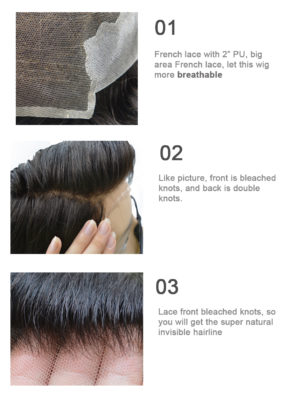Overview of Toupee Hairpieces
What is a Toupee Hairpiece?
A toupee, commonly known as a hairpiece, is a partial wig or hair extension used to cover bald spots or thinning hair areas. Typically made from real human hair, synthetic fibers, or a blend of both, toupees are designed to seamlessly integrate with the wearer’s existing hair. They serve not only aesthetic purposes but also provide a confidence-boosting solution for individuals experiencing hair loss due to genetics, medical conditions, or other reasons.
The History and Evolution of Toupee Hairpieces
The history of toupee hairpieces dates back to ancient Egypt, where hair adornments were used for beautification or for religious and cultural reasons. Over time, the manufacturing techniques and materials of toupees have significantly evolved. In the 20th century, with the invention of synthetic fibers and the influence of popular culture, toupees gained widespread popularity.
Initially, toupees were primarily made from natural human hair, which was expensive and challenging to maintain. Advances in technology introduced synthetic fibers as a more affordable and low-maintenance alternative. Modern toupees not only innovate in materials but also in design and craftsmanship, blending more naturally with the wearer’s hair and offering a more comfortable experience.
Today, the toupee market is diverse, catering not just to those with hair loss but also to fashion enthusiasts, actors, and others who seek to alter their hairstyle or hair color for various reasons. With the rise of personalization and custom services, the application of toupees has broadened, meeting the unique needs of different users.
In the following sections, we will explore the various types and applications of toupee hairpieces and how they have become an integral part of the modern fashion and beauty industry.

Types and Applications of Toupee Hairpieces
Different Types of Toupee Hairpieces
Toupee hairpieces come in various forms, each designed to cater to specific needs and preferences. The main types include:
- Human Hair Toupees: Made from real human hair, these toupees offer a natural look and feel. They can be styled, colored, and treated just like natural hair, making them a popular choice for those seeking a realistic appearance.
- Synthetic Hair Toupees: Constructed from artificial fibers, synthetic toupees are less expensive than human hair toupees and require less maintenance. They hold their style longer but offer less versatility in styling.
- Custom Toupees: These are tailor-made to fit the individual’s head shape, hair color, density, and style preferences. Custom toupees provide the most natural look as they are designed to seamlessly blend with the wearer’s existing hair.
- Stock Toupees: These are pre-made and ready-to-wear options available in standard sizes and styles. They are a convenient choice for those looking for a quick solution.
Applications of Toupee Hairpieces
Toupee hairpieces are used in various scenarios, such as:
- Aesthetic Enhancement: For individuals looking to enhance their appearance by adding volume or covering bald spots.
- Medical Conditions: People suffering from hair loss due to medical conditions like alopecia or chemotherapy find toupees a beneficial solution.
- Fashion and Styling: Fashion enthusiasts and stylists use toupees to experiment with different hairstyles and colors without altering their natural hair.
- Entertainment Industry: Actors and performers often use toupees for character roles that require a specific hairstyle or look.
Advantages of Chinese Toupee Hairpiece Manufacturers
Global Impact of Made in China
China has emerged as a leading player in the toupee hairpiece manufacturing industry. The country’s manufacturers are known for their large-scale production capabilities, offering a wide range of options at competitive prices. The “Made in China” tag has become synonymous with affordability and variety in the global hairpiece market.
Characteristics of Chinese Manufacturers
Chinese toupee manufacturers are recognized for:
- Mass Production: Ability to produce large quantities, catering to both small and large orders.
- Quality and Variety: Offering a diverse range of quality products, from luxury human hair toupees to budget-friendly synthetic options.
- Customization Services: Providing custom-made solutions tailored to individual client requirements.
- Innovative Technologies: Utilizing advanced technologies in hairpiece design and manufacturing processes.
- Global Supply Chain: Efficiently managing a global supply chain, ensuring timely delivery to international clients.
In the next section, we will delve into the importance of custom services in the toupee hairpiece industry and how to select the right custom toupee.
Custom Services: Tailoring the Perfect Toupee Hairpiece
The Importance of Customization
Customization in toupee hairpieces is crucial for achieving a look that is indistinguishable from natural hair. It involves tailoring a hairpiece to match the wearer’s hair color, texture, density, and scalp shape. This personalization ensures that the toupee blends seamlessly with the existing hair, providing a natural and undetectable appearance.
Choosing the Right Custom Toupee
To select the ideal custom toupee, consider the following factors:
- Hair Type: Decide between human hair or synthetic fibers based on your styling needs and maintenance preferences.
- Base Material: The base of the toupee should be comfortable and breathable. Options include lace, skin, and monofilament, each offering different levels of durability and natural appearance.
- Color Matching: Ensure the color of the toupee matches your natural hair. Custom toupees offer the advantage of precise color matching.
- Density and Texture: The hair density and texture should complement your natural hair for a cohesive look.
- Head Measurement: Accurate head measurements are essential for a snug and comfortable fit.
Cost and Price: Economic Considerations of Toupee Hairpieces
Cost Structure of Toupee Hairpieces
The cost of a toupee hairpiece varies based on several factors:
- Material: Human hair toupees are generally more expensive than synthetic ones due to their natural appearance and versatility.
- Construction: Hand-tied toupees cost more due to the labor-intensive process, but they offer a more natural look.
- Customization: Custom-made toupees are pricier than stock models, reflecting the personalized craftsmanship involved.
Assessing the Value of Toupee Hairpieces
When evaluating the cost-effectiveness of a toupee, consider:
- Durability: A higher initial cost might be justified if the toupee lasts longer and requires less maintenance.
- Aesthetics: The natural appearance and comfort of a more expensive toupee might be worth the extra cost.
- Usage: Frequent wearers might find it economical to invest in a higher-quality, durable toupee.
Manufacturing Process: From Design to Finished Product
The Production Flow of Toupee Hairpieces
The manufacturing process of toupee hairpieces involves several steps:
- Design: Creating a blueprint based on the customer’s specifications.
- Material Selection: Choosing the right hair and base materials.
- Knotting: Hand-tying or machine-sewing hair onto the base.
- Styling and Coloring: Customizing the hairpiece to the desired style and color.
- Quality Control: Rigorous testing for durability, appearance, and comfort.
Quality Control and Technological Innovations
Quality control is paramount in the production of toupees. Manufacturers employ various techniques to ensure the hairpieces meet high standards. Technological innovations, such as 3D printing for scalp measurements and advanced knotting techniques, have significantly improved the quality and realism of toupees.
In the next section, we will explore the key considerations for international buyers when choosing a toupee hairpiece supplier, particularly from China.
Choosing a Supplier: Key Considerations for International Buyers
How to Select the Right Toupee Hairpiece Supplier
For international buyers, selecting the right supplier is crucial. Here are some key factors to consider:
- Reputation and Experience: Look for suppliers with a strong reputation and years of experience in the industry. This often indicates reliability and quality.
- Product Range: Choose a supplier with a wide range of products to cater to diverse needs.
- Customization Capabilities: Ensure the supplier can provide custom solutions if required.
- Quality Assurance: Check for quality control processes and certifications.
- Customer Service: Good customer service, including communication and after-sales support, is essential.
- Pricing: While competitive pricing is important, it shouldn’t compromise the quality of the products.
Questions International Buyers Should Ask Chinese Suppliers
When dealing with Chinese suppliers, international buyers should inquire about:
- Production Capacity: Can they handle your volume requirements?
- Lead Times: How long will it take to produce and deliver the products?
- Minimum Order Quantities (MOQs): What are the minimum order requirements?
- Shipping and Handling: What are the logistics and costs involved in shipping?
- Payment Terms: What are the payment conditions and methods accepted?
- Return Policy: In case of issues, what is the return or exchange policy?
Market Trends and Future Outlook in the Toupee Hairpiece Industry
Current Market Trends
The toupee hairpiece market is witnessing several trends:
- Rising Demand for Customization: Personalized toupees are becoming increasingly popular.
- Technological Advancements: Innovations in manufacturing and materials are enhancing the quality and realism of toupees.
- Growing Awareness: There’s a growing awareness and acceptance of hairpieces as a solution for hair loss.
- Diverse Applications: Beyond hair loss solutions, toupees are being used for fashion and entertainment purposes.
Future Developments in the Industry
The future of the toupee industry looks promising with:
- Sustainable Practices: A shift towards eco-friendly materials and processes.
- E-commerce Growth: Online platforms are becoming a key channel for purchasing toupees.
- Global Expansion: Increasing demand in emerging markets.
- Innovative Solutions: Continued research and development in hairpiece technology.
FAQ Section for Toupee Hairpieces
General Questions
- What is the lifespan of a toupee hairpiece?
- The lifespan varies depending on the material and how well it’s maintained. Generally, human hair toupees can last up to a year or more, while synthetic ones may last for a few months.
- Can toupees be worn during physical activities or swimming?
- Yes, but it’s important to choose a toupee with a secure fit. Waterproof adhesives and special designs are available for active lifestyles.
- How do I match the toupee to my natural hair color?
- Professional color matching services are recommended. Custom toupees offer precise color matching.
Maintenance and Care
- How often should a toupee be cleaned?
- It’s recommended to clean the toupee every 2-4 weeks, depending on usage and environmental factors.
- Can I style a toupee with heating tools?
- Human hair toupees can be styled with heating tools, but it’s advisable to use low heat settings. Synthetic toupees may not withstand high heat.
- What’s the best way to store a toupee when not in use?
- Store it on a mannequin head or in a silk or satin bag to maintain its shape and prevent tangling.
Customization and Fitting
- How is a custom toupee fitted?
- Custom toupees require precise head measurements. Some suppliers offer 3D scanning for an accurate fit.
- Can a toupee be adjusted if it doesn’t fit perfectly?
- Yes, adjustments can be made by a professional to ensure a better fit.
- Are there hypoallergenic options for sensitive scalps?
- Yes, hypoallergenic bases and materials are available for those with sensitive skin.
Purchasing and Selection
- How do I choose between a human hair and synthetic toupee?
- Consider factors like natural appearance, maintenance, styling flexibility, and budget. Human hair offers more realism and styling options, while synthetic is more budget-friendly and low-maintenance.
- What should I look for in a high-quality toupee?
- Look for natural hairline, good quality hair or fibers, comfortable and breathable base, and strong, yet comfortable adhesion.
- Can I buy a toupee online?
- Yes, many reputable suppliers sell toupees online. Ensure you understand their return and exchange policies before purchasing.
Advanced Considerations
- Are there any new technologies in toupee development?
- Innovations like 3D printed bases and advanced knotting techniques are emerging, offering more natural and comfortable fits.
- How can I ensure my toupee looks natural?
- Choose a style and color that matches your natural hair, ensure a proper fit, and opt for professional styling and maintenance.
- What are the latest trends in toupee styles?
- Current trends include natural-looking hairlines, lightweight bases, and styles that cater to younger demographics.



